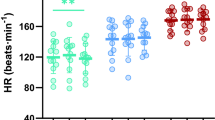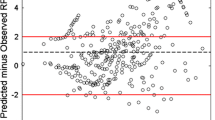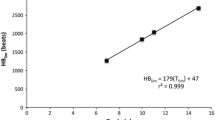Summary
Two cycle ergometer protocols for assessing perceived exertion were compared before and after a fatiguing run. In the response (R) protocol, the subject rated the perceived exertion (RPE) of a series of power outputs assigned by the investigator. In the production (P) protocol, the investigator selected the RPE values and the subject adjusted his power output using a handheld control. The relationship between RPE and power output (the regression coefficient and the slope and intercept of the regression line) was the same for both protocols. Fatigue due to the run caused a small increase in RPE (average 1.5 units) at a given exercise intensity and a commensurate decrease in power output (average 19 W) for a given RPE. The P protocol is safer than the R protocol because it makes no assumptions with regard to the physical condition of the subject. It is superior to the R protocol because it is an interval scale. These advantages suggest that the P protocol should be used instead of, or at least in addition to, the more traditional R protocol.
Similar content being viewed by others
References
Borg GA (1970) Perceived exertion as an indicator of somatic stress. Scand J Rehab Med 2:92–98
Borg GA (1982) Psychophysical bases of perceived exertion. Med Sci Sports Exerc 14:377–381
Borg GA, Linderholm H (1967) Exercise performance and perceived exertion in patients with coronary insufficiency, arterial hypertension and vasoregulatory asthenia. Acta Med Scand 187:17–26
Borg GA, Edgren B, Marklund G (1971) A simple walk test of physical working capacity. Report of Inst Appl Psychol, University Stockholm, No. 57
Cain WS (1977) Versatility of the constant-effort procedure. In: Borg GA (ed) Physical work and effort. Pergamon Press, Oxford
Carton RL, Rhodes EC (1985) A critical review of the literature on rating scales for perceived exertion. Sports Med 2:198–222
Edgren B (1977) A work test based on preferred settings. In: Borg GA (ed) Physical work and effort. Pergamon Press, Oxford
Gutman MC, Squires RW, Pollock ML, Foster C, Anholm J (1981) Perceived exertion — heart rate relationship during exercise testing and training in cardiac patients. J Cardiol Rehab 1:52–59
Harris DA, Pegram GV, Hartman BO (1971) Performance and fatigue in experimental double-crew transport missions. Aviat Space Environ Med 42:980–986
Kinsman RA, Weiser PC (1976) Subjective symptomatology during work and fatigue. In: Simonson E, Weiser PC (eds) Psychological aspects and physiological correlates of work and fatigue. C. H. Thomas, Springfield, Illinois
Martin B, Haney R (1982) Self-selected exercise intensity is unchanged by sleeploss. Eur J Appl Physiol 49:79–86
Michael ED, Eckhardt L (1972) The selection of hard work by trained and non-trained subjects. Med Sci Sports Exerc 4:107–110
Mihevic PM (1981) Sensory clues for perceived exertion: a review. Med Sci Sports Exerc 13:150–163
Myles WS (1985) Sleep deprivation, physical fatigue, and the perception of exercise intensity. Med Sci Sports Exerc 17:580–584
Noble BJ (1982) Clinical applications of perceived exertion. Med Sci Sports Exerc 14:406–411
Pandolf KB (1982) Differential ratings of perceived exertion during physical exercise. Med Sci Sports Exerc 14:397–405
Smutok MA, Skrinar GS, Pandolf KB (1980) Exercise intensity: Subjective regulation by perceived exertion Arch Physiol Med Rehab 61:569–574
Author information
Authors and Affiliations
Additional information
This paper is DCIEM Publication No. 86-P-38
Rights and permissions
About this article
Cite this article
Myles, W.S., Maclean, D. A comparison of response and production protocols for assessing perceived exertion. Europ. J. Appl. Physiol. 55, 585–587 (1986). https://doi.org/10.1007/BF00423201
Accepted:
Issue Date:
DOI: https://doi.org/10.1007/BF00423201




